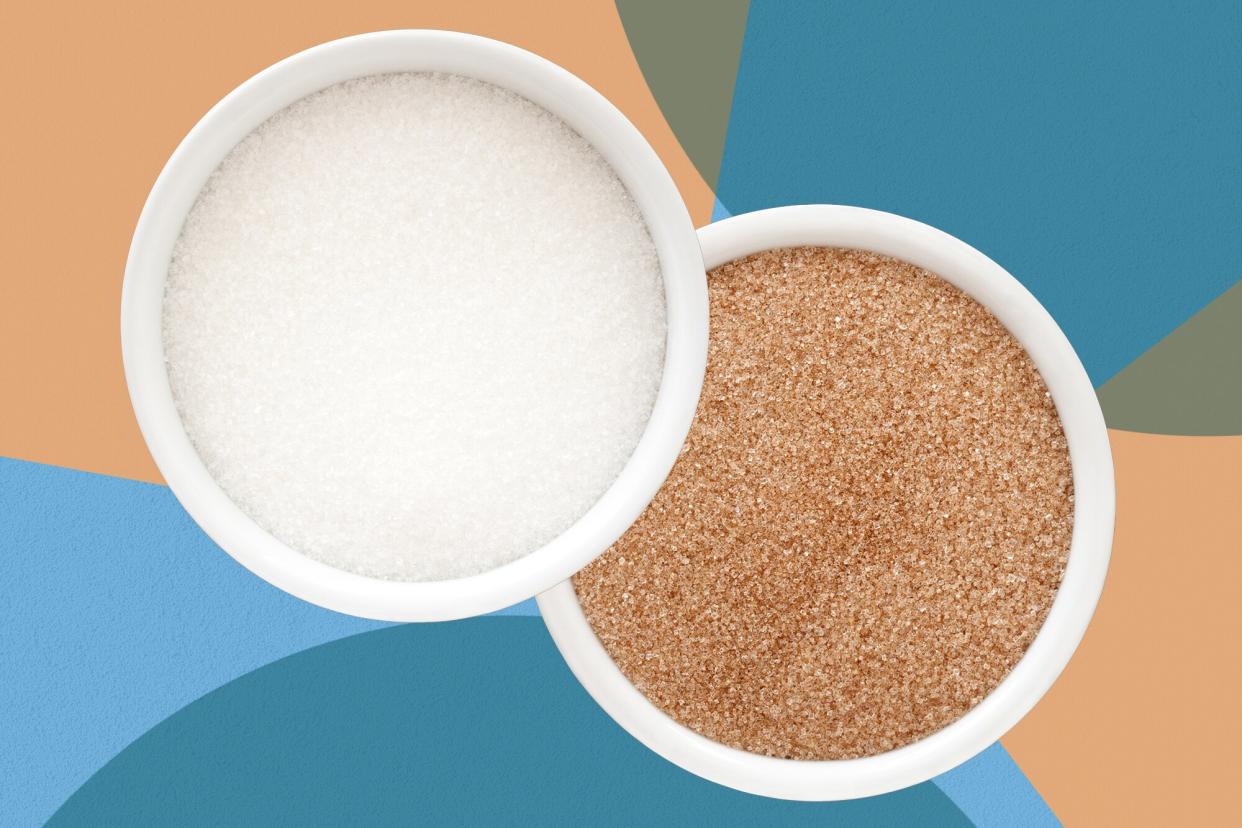Brown Sugar vs. White Sugar: What's the Difference?

Getty Images
Which sugar should you reach for, brown or white? There's more to these common sugar varieties than you'd think, including similarities and differences you probably didn't know about. We spoke with the Sugar Association to get all the info you need to know about white sugar, brown sugar and everything in between.
Related: Sea Salt vs. Table Salt: What's the Difference?
What Is White Granulated Sugar?
Through photosynthesis, sugar is made from the leaves of a sugar cane or sugar beet plant. It is stored as a juice in the stalks (cane) or root (beet) of the plant, before being harvested and sent off to be refined. The cane juice is extracted, purified, filtered and crystallized. Through varying adjustments in the refining process, different varieties of sugar can be created. One such sugar is the white granulated sugar you likely are familiar with from baking or stirring into your morning tea or coffee.
What Is Brown Sugar?
Light brown sugar is white sugar with the presence of molasses. The molasses gives the sugar more moisture (making its texture softer), a darker color and a light caramel-like flavor. Molasses is naturally found in sugar cane and sugar beet plants, and is separated from the sugar crystals to create white sugar in the refining process.
When we discuss brown sugar, that's mostly in reference to light brown sugar. But don't forget about dark brown sugar! Dark brown sugar has nearly twice the amount of molasses present, which is the reason for its darker color. But it's not just the color that's different: dark brown sugar also has a deeper flavor than light brown sugar, so keep that in mind if you're planning to swap them in a recipe.
The Sugar Association notes, "The relative [higher] acidity of molasses may be a consideration with regard to baking and recipes that are sensitive to specific rise or spread, so this should be noted when using dark over light."
One downside of brown sugar (both light and dark) that many home chefs have likely experienced is opening up your box, bag or jar only to find an impenetrable rock inside. This happens when the moisture dries up, likely due to improper storage or aging. It's still perfectly fine to use once softened, but try storing your sugar in an airtight container instead of the original packaging next time.
How Are They Used Differently?
While they can sometimes be used interchangeably depending on the recipe, both light and dark brown sugar have their own uses as well. The Sugar Association recommends using dark brown sugar in recipes that have a "richer flavor profile such as spice cakes, gingerbreads, and barbecue sauces. On the other hand, recipes calling for light brown sugar include sweet sauces, marinades, and rubs." But if the recipe you are following doesn't specify what type of brown sugar to use, your best bet is to use light brown.
By "varying the level of molasses, different sugar varieties are possible, including all the varieties of brown sugar," the Sugar Association says. These sugars each vary in molasses and moisture content, and crystal size, giving them their own unique applications in cooking and eating. Here are some of the more prevalent varieties.
Turbinado: Raw sugar is the residue left after sugar cane has been processed to remove the molasses and refine the sugar crystals. Turbinado sugar is raw sugar that has been processed using steam heat. The crystals are blond-ish and have a delicate molasses flavor.
Demerara: This is also a raw sugar known for it coarse texture and dry crystals. It is processed in the Demerara area of Guyana, and is often used in cocktails.
Muscovado: This sugar is less refined than white sugar, maintaining some of its natural molasses content, and may be used in a wide variety of ways, from barbecue sauce to oatmeal to baked goods.
White sugar is typically categorized by crystal size. Here are a few white sugar varieties to look out for on your next grocery store run, and some common uses for them:
Granulated: This is the most common type of sugar, good for everything from adding to your morning coffee to mixing into your favorite baked goods.
Sanding: This type of sugar looks almost sparkling, and is often used in baking as a decorative touch.
Superfine: Sometimes called caster sugar, superfine sugar dissolves easily and is used in delicate desserts like pudding or mousse.
Powdered: Granulated sugar is ground into an ultra-smooth powder, also known as confectioners' sugar. This is often used to make homemade icing or whipped cream.
Nutritional Values
When taking a look at the nutrition label, you'll likely see sugar and added sugars listed. The total sugars in a product include the naturally occurring sugars that are inherently present in foods such as dairy products and fruit, plus any added sugars that are added to foods and beverages during processing and cooking. White and brown sugars are added sugars. (Somewhat confusingly, sometimes any sugars that are made from plants—sugar cane, sugar beets, agave, maple syrup, honey, etc.—are referred to as "natural." Yet, if they are added to a food, they count as added sugars.)
From a nutrition perspective, there's no advantage to using white sugar over brown sugar or vice versa, the Sugar Association says: "Nutritionally speaking, all natural sugars have relatively comparable nutritional value with approximately 15 calories per teaspoon (4.2 g)."
Bottom Line
The main difference between white sugar and brown sugar is the presence of molasses. This gives brown sugar a distinctive flavor, color and moisture level that makes it stand out from regular white table sugar.

